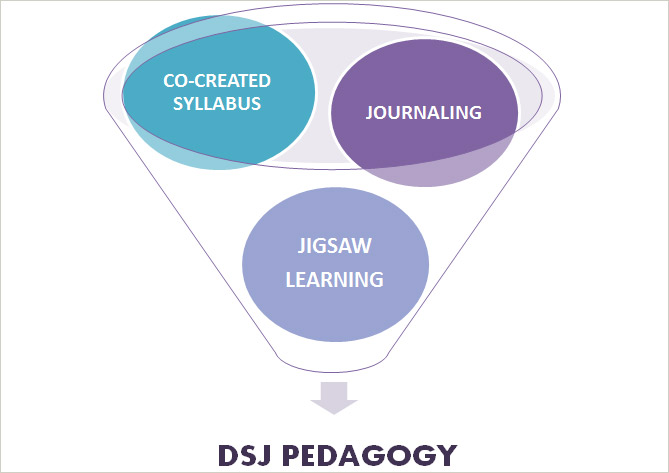Co-Creating the Course Syllabus
-
The purpose of a co-created syllabus is to build a stronger connection between the student and the course, by allowing students to have a more active role in selecting what will be discussed and taught in the class.
-
Students cannot co-create the entire syllabus. There are various areas that are required to be included in the syllabus (e.g. academic dishonesty policy, accessibility services, course description, etc.). However, students can collaborate of things like the order of topics discussed (favorite topics – least favorite), how participation should be measured (do they have to engage in discussion, should there be a sign-in sheet, etc.), and/or even preferences for group work, exams or papers.
-
Developing a co-created syllabus required research about how the process works, structure, and deciding what the students would be in charge of selecting. The articles listed below were used in the development of the co-created syllabus.
- Gibson, L. (2011). Self-directed learning: An exercise in student engagement. College Teaching, 59(3), 95-101.
- Hudd, S.W. (2003). Syllabus under construction: Involving students in the creation of class assignments. Teaching Sociology, 31(2), 195-202.
-
1. Inaugural Email
First, send an email out to your students informing them that they will be co-creating the class syllabus. In this email an explanation of a co-created syllabus should be provided, as well as the objective of working as a team to create the syllabus. This email should also contain a link to and instructions for all students to complete a learning style assessment (Visual/Audio/Reading/Writing/ Kinesthetic or VARK test) before the first class. This information should also be incorporated into the process of co-creation. By providing students with this information, it may help to reduce anxiety of students who require structure. Moreover, it is suggested that the professor also takes the opportunity to welcome students to inquire about the course. Generally multiple questions arise for students about how hard the class/professor will be, if they have to buy the book, will there be more essay writing or cumulative exams, etc. This is an excellent way to establish and encourage communication among students at the outset of the course.
2. Syllabus Poll
Second, draft a Syllabus Poll, a list of questions for the students to answer. The discussion on the first day will be based on this poll. These questions should be tied to the actual co-creation of the syllabus and should provide useful information about, for example:
- The students learning style,
- Primary topics that the students are most interested in covering during lessons/lectures,
- Students' attitudes toward group work,
- How the students feel participation should be measured,
- The number of times students visit office hours, and
- How the students preferred to be assessed (term papers vs. quizzes vs. midterm/final).
Other useful information to gain while facilitating the co-created syllabus is each student's major and the reason why they selected your course. Next, decide how to administer and facilitate the survey, like poll everywhere, handouts, clickers, and/or survey monkey. Moreover, if you elect a technological approach (i.e. poll everywhere) conduct a trial run by visiting the classroom to test for reception and/or internet access.
Always prepare a back-up plan (i.e. handout) to use in case of technical difficulties. If your room does present technical issues, then, email a copy of the survey questions to the students. This will give them an opportunity to read over the questions and think about their response prior to the 1st day.
On the first day, explain to the students what the co-created syllabus is, why they are co-creating one, and how it is beneficial. Begin giving students directions about how to take the survey. Hi-tech approaches like poll everywhere are beneficial because it is more interactive, anonymous, and the results can be viewed live. If you are located in a computer lab survey monkey is also beneficial because each student can take the survey independently then as a class you can view the results. However, paper surveys are equally as sufficient, but it may take longer to compile data and the students do NOT receive immediate results. Next, as the students provide responses to the survey questions engage in brief discussion about each question. For example, if many students are visual learners talk about ways you will teach/lecture to support their learning style (feedback/response, etc.).
3. Syllabus Completion
After everyone has finished their surveys provide students with a day that they will be receiving the official syllabus. Ideally, the completed official syllabus should be completed by the 2nd day of class. This does present a substantial amount of work between the first and second classes, however, it is important to concretize the syllabus as soon as humanly possible to diminish student uncertainty.
4. Mix It Up and Have Fun!
Most importantly - have fun mixing it up! Developing our pedagogy not only has benefits for our students, WE can also benefit from the novelty.
